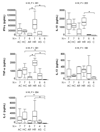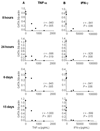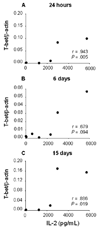T-bet, GATA-3, and Foxp3 expression and Th1/Th2 cytokine production in the clinical outcome of human infection with Leishmania (Viannia) species
- PMID: 20583921
- PMCID: PMC4850829
- DOI: 10.1086/653829
T-bet, GATA-3, and Foxp3 expression and Th1/Th2 cytokine production in the clinical outcome of human infection with Leishmania (Viannia) species
Abstract
Background: T cell differentiation determines susceptibility and resistance to experimental cutaneous leishmaniasis, yet mixed T1/Th2 responses characterize the clinical spectrum of human infection with Leishmania (Viannia) species.
Materials and methods: To discern the interrelationship of T cell differentiation and outcome of human infection, we examined factors that regulate T cell differentiation and Th1/Th2 cytokine responses in asymptomatic infection, active and historical chronic and recurrent cutaneous leishmaniasis. T-bet, GATA-3, Foxp3, and cytokine gene expression were quantified by real-time polymerase chain reaction and correlated with interleukin 2, interferon gamma, tumor necrosis factor alpha, interleukin 4, interleukin 13, and interleukin 10 secretion during in vitro response to live Leishmania panamensis.
Results: Higher GATA-3 expression than T-bet expression occurred throughout the 15 days of coculture with promastigotes; however, neither transcription nor secretion of interleukin 4 was detected. A sustained inverse correlation between GATA-3 expression and secretion of proinflammatory cytokines interferon gamma and tumor necrosis factor alpha was observed in asymptomatic infection. In contrast, higher T-bet expression and a higher ratio of T-bet to GATA-3 characterized active recurrent disease. Down-regulation of T-bet and GATA-3 expression and increased interleukin 2 secretion, compared with control subjects, was directly correlated with Foxp3 expression and interleukin 13 secretion in chronic disease.
Conclusions: Regulation of the inflammatory response rather than biased Th1/Th2 response distinguished asymptomatic and recalcitrant outcomes of infection with Leishmnania viannia species.
Conflict of interest statement
None of the authors have a commercial or other association that might pose a conflict of interest in the conduct of this study or the publication of the results
Figures






References
-
- Marsden PD. Clinical presentations of Leishmania braziliensis braziliensis. Parasitol Today. 1985;1:129–133. - PubMed
-
- Weigle KA, Saravia NG. Natural History, Clinical Evolution, and the Host-Parasite Interaction in New World Cutaneous Leishmaniasis. Clin Dermatol. 1996;14:433–450. - PubMed
-
- Saravia NG, Weigle KA, Segura I, et al. Recurrent lesions in human Leishmania braziliensis infection: reactivation or reinfection? Lancet. 1990;336:398–402. - PubMed
-
- Ramírez JL, Guevara P. Persistent infections by Leishmania (Viannia) braziliensis. Mem Inst Oswaldo Cruz. 1997;92:333–338. Review. - PubMed
-
- Schubach A, Marzochi MC, Cuzzi-Maya T, et al. Cutaneous scars in American tegumentary leishmaniasis patients: a site of Leishmania (Viannia) braziliensis persistence and viability eleven years after antimonial therapy and clinical cure. Am J Trop Med Hyg. 1998;58:824–827. - PubMed
Publication types
MeSH terms
Substances
Grants and funding
LinkOut - more resources
Full Text Sources
Medical
Molecular Biology Databases

